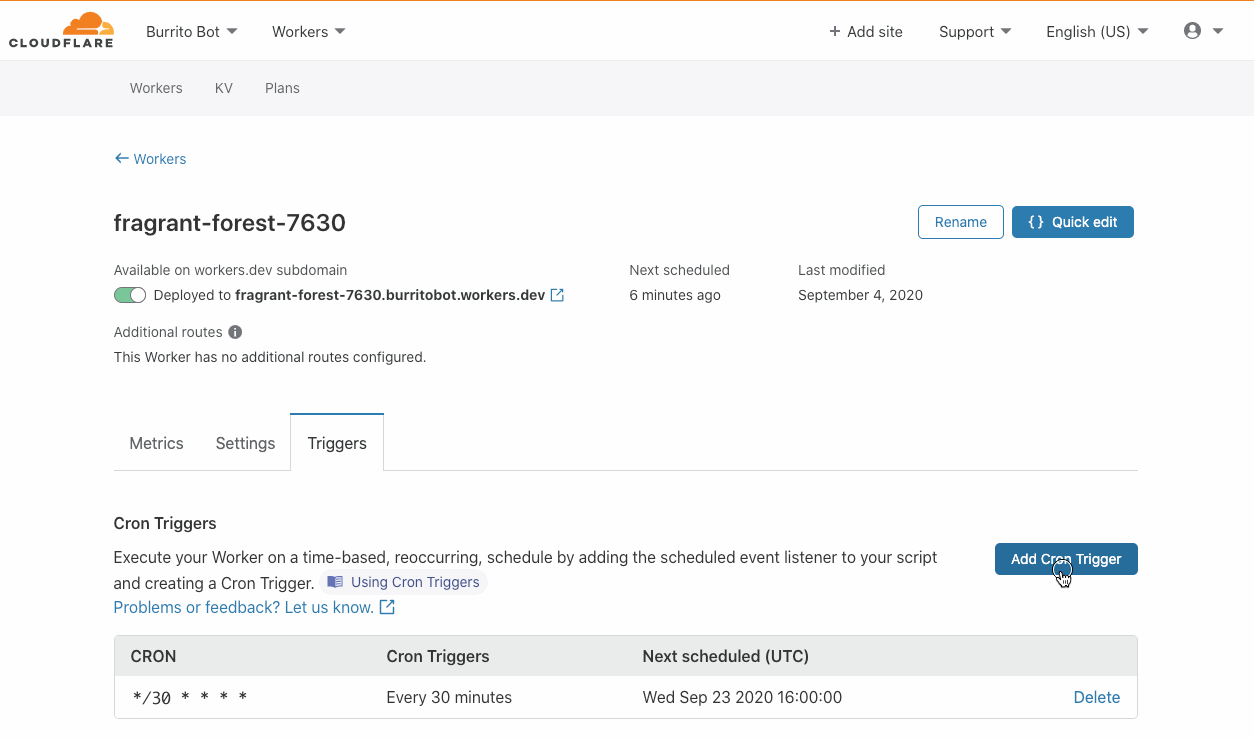Making Time for Cron Triggers: A Look Inside


Today, we are excited to launch Cron Triggers to the Cloudflare Workers serverless compute platform. We’ve heard the developer feedback, and we want to give our users the ability to run a given Worker on a scheduled basis. In case you’re not familiar with Unix systems, the cron pattern allows developers to schedule jobs to run at fixed intervals. This pattern is ideal for running any types of periodic jobs like maintenance or calling third party APIs to get up-to-date data. Cron Triggers has been a highly requested feature even inside Cloudflare and we hope that you will find this feature as useful as we have!

Where are Cron Triggers going to be run?
Cron Triggers are executed from the edge. At Cloudflare, we believe strongly in edge computing and wanted our new feature to get all of the performance and reliability benefits of running on our edge. Thus, we wrote a service in core that is responsible for distributing schedules to a new edge service through Quicksilver which will then trigger the Workers themselves.
What’s happening under the hood?
At a high level, schedules created through our API create records in our database with the information necessary to execute Continue reading
Security’s Role in Client to Cloud Networking
The Networking industry is undergoing a metamorphosis. Modern networking operations teams are challenged to cope with multiple operational models. As attackers become better and better at breaching our defenses, security analysts are increasingly at the heart of a security organization. The operators are responsible for detecting, investigating and remediating potential breaches before they progress into brand, customer, financial and IP damage. This confluence of DevOps, NetOps, SecOps, and CloudOps demands persistent operations control. How do you cope with decades of security, threat and cyber detection done in reactive silos? What happens as more workloads move to the cloud? At Arista, we value our ecosystem of security partners and networking must adapt to the new complex threats.
Security’s Role in Client to Cloud Networking
The Networking industry is undergoing a metamorphosis. Modern networking operations teams are challenged to cope with multiple operational models. As attackers become better and better at breaching our defenses, security analysts are increasingly at the heart of a security organization. The operators are responsible for detecting, investigating and remediating potential breaches before they progress into brand, customer, financial and IP damage. This confluence of DevOps, NetOps, SecOps, and CloudOps demands persistent operations control. How do you cope with decades of security, threat and cyber detection done in reactive silos? What happens as more workloads move to the cloud? At Arista, we value our ecosystem of security partners and networking must adapt to the new complex threats.
Workers Durable Objects Beta: A New Approach to Stateful Serverless


We launched Cloudflare Workers® in 2017 with a radical vision: code running at the network edge could not only improve performance, but also be easier to deploy and cheaper to run than code running in a single datacenter. That vision means Workers is about more than just edge compute -- we're rethinking how applications are built.
Using a "serverless" approach has allowed us to make deploys dead simple, and using isolate technology has allowed us to deliver serverless more cheaply and without the lengthy cold starts that hold back other providers. We added easy-to-use eventually-consistent edge storage to the platform with Workers KV.
But up until today, it hasn't been possible to manage state with strong consistency, or to coordinate in real time between multiple clients, entirely on the edge. Thus, these parts of your application still had to be hosted elsewhere.
Durable Objects provide a truly serverless approach to storage and state: consistent, low-latency, distributed, yet effortless to maintain and scale. They also provide an easy way to coordinate between clients, whether it be users in a particular chat room, editors of a particular document, or IoT devices in a particular smart home. Durable Objects are the missing piece Continue reading
Syncing RIPE, ARIN and APNIC objects with a custom Ansible module
Internet is split into five regional Internet registry: AFRINIC, ARIN, APNIC, LACNIC and RIPE. Each RIR maintains an Internet Routing Registry. An IRR allows one to publish information about the routing of Internet number resources.1 Operators use this to determine the owner of an IP address and to construct and maintain routing filters. To ensure your routes are widely accepted, it is important to keep the prefixes you announce up-to-date in an IRR.
There are two common tools to query this database: whois and
bgpq4. The first one allows you to do a query with the WHOIS
protocol:
$ whois -BrG 2a0a:e805:400::/40 […] inet6num: 2a0a:e805:400::/40 netname: FR-BLADE-CUSTOMERS-DE country: DE geoloc: 50.1109 8.6821 admin-c: BN2763-RIPE tech-c: BN2763-RIPE status: ASSIGNED mnt-by: fr-blade-1-mnt remarks: synced with cmdb created: 2020-05-19T08:04:58Z last-modified: 2020-05-19T08:04:58Z source: RIPE route6: 2a0a:e805:400::/40 descr: Blade IPv6 - AMS1 origin: AS64476 mnt-by: fr-blade-1-mnt remarks: synced with cmdb created: 2019-10-01T08:19:34Z last-modified: 2020-05-19T08:05:00Z source: RIPE
The second one allows you to build route filters using the information contained in the IRR database:
$ bgpq4 -6 -S RIPE -b AS64476 NN = [ 2a0a:e805::/40, 2a0a:e805:100::/40, 2a0a:e805:300::/40, 2a0a:e805:400::/40, 2a0a:e805:500::/40 ];
There is no module available on Ansible Galaxy Continue reading
Understanding Linux Networking
Got this interesting question from one of my readers
Based on my experience, the documentation regarding Linux networking is either elementary man pages for user-space utilities or very complicated Linux kernel source code. Does getting deep into Linux networking mean reading source code?
It all depends on how deep you plan to go:
Deploying whitebox switches. If you’re just starting you SHOULD buy a supported solution that includes hardware and a variant of Linux running on it. Your problem transformed into “configuring control-plane protocols on Linux”. Congratulations, you’ll be perfectly fine studying Cumulus Networks documentation. Apart from the secret-sauce-ASIC-blob they’re using open-source software, so whatever you learn there should be transferrable to any other Linux networking environment.
However, even though the documentation is pretty good, expect a few gotchas. As Dinesh Dutt told me:
- Unlike a traditional NOS, Linux is not a monolithic entity. There’s the kernel and there are software packages than run on top. To make installation and management easier, different folks put together Continue reading
The Secret to an Effective Multicloud Strategy Is…an Actual Strategy
The work isn’t done once a multicloud strategy is defined. It will need to keep evolving to meet, (and ideally, anticipate,) changing demands and needs.What Cyber Lessons Can the Military Teach the Private Sector?
Besides trying to avoid attack, the military focuses on resilience – the ability to limit the damage from attacks and to recover quickly afterward.A letter from Cloudflare’s founders (2020)

To our stakeholders:
Cloudflare launched on September 27, 2010 — 10 years ago today. Stopping to look back over the last 10 years is challenging in some ways because so much of who we are has changed radically. A decade ago when we launched we had a few thousand websites using us, our tiny office was above a nail salon in Palo Alto, our team could be counted on less than two hands, and our data center locations on one hand.

As the company grew, it would have been easy to stick with accelerating and protecting developers and small business websites and not see the broader picture. But, as this year has shown with crystal clarity, we all depend on the Internet for many aspects of our lives: for access to public information and services, to getting work done, for staying in touch with friends and loved ones, and, increasingly, for educating our children, ordering groceries, learning the latest dance moves, and so many other things. The Internet underpins much of what we do every day, and Cloudflare’s mission to help build a better Internet seems more Continue reading
Welcome to Birthday Week 2020

Each year we celebrate our launch on September 27, 2010 with a week of product announcements. We call this Birthday Week, but rather than receiving gifts, we give them away. This year is no different, except that it is… Cloudflare is 10 years old.
Before looking forward to the coming week, let’s take a look back at announcements from previous Birthday Weeks.

A year into Cloudflare’s life (in 2011) we launched automatic support for IPv6. This was the first of a long line of announcements that support our goal of making available to everyone the latest technologies. If you’ve been following Cloudflare’s growth you’ll know those include SPDY/HTTP/2, TLS 1.3, QUIC/HTTP/3, DoH and DoT, WebP, … At two years old we celebrated with a timeline of our first two years and the fact that we’d reached 500,000 domains using the service. A year later that number had tripled.

In 2014 we released Universal SSL and gave all our customers SSL certificates. In one go we massively increased the size of the encrypted web and made it free and simple to go from http:// to https://. Other HTTPS related features we’ve Continue reading
Duty Calls: Technologies that Didn’t: CLNS
Russ White published an interesting story explaining why we’re using IP and not CLNS to build today’s Internet.
Let’s start with a few minor details he missed that I feel obliged to point out (apologies to Russ for being too pedantic, but you know me…):
New ACI deployment? Watch out when connecting APICs to Leafs
It’s one of those articles aimed at the people with Cisco ACI experience who don’t bother with reading all the install and other guides again while going through n’th time of building and ACI fabric, like me. When it comes to Cisco ACI, you really should. There’s a small change with the physical build of the third generation of APIC server where 10G SFP interfaces from APIC towards the Leaf switches (used for fabric discovery and later for the in-band controller to fabric communication) where 4x10G card is built in the server and not like 2x10G on M2/L2 and other
The post New ACI deployment? Watch out when connecting APICs to Leafs appeared first on How Does Internet Work.
Configure NXOS with Napalm
Napalm offers an easy way to configure and gather information from network devices using a unified API. No matter what vendor it is used against the input task and returned output will be the same. The only thing that will not be vendor neutral is the actual commands run and configuration being applied. This post documents experiences of trying to replace the whole configuration on NXOS using Napalm with Ansible.
Aws Deeplens – meet the devil dog – part 1

Now on first look she is so adorable, don’t be fooled by looks this dog is responsible for destruction of usb cables, foot wear , headphones, trash can openings and garden destruction.
Idea inspired from : https://youtu.be/ALKz1eKj4n0
Aws deeplens – https://aws.amazon.com/deeplens/



So here is the idea, over the course of next few days to months, I will start capturing many constructive and destructive images of my dog and start training a AI model which will give us a reasonable idea on what exactly she is up to when we leave her alone and alert us accordingly.
Am not a ML developer let alone be an expert, but aws makes it easy to train and deploy models and you don’t have to know much to get started. I developed another ML model with aws rekognition which identifies unwanted plants and shrubs in a raised bed.
I got set up this deeplens and deployed a model project in no less than 5 minutes and am being honest. Here is a sample model which identifies cat vs dog , this model comes is among example models.

It has a Mqtt topic which you can subscribe as well

-Rakesh
Worth Reading: Iron Chef – Certification Edition
In one of his recent blog posts Tom Hollingsworth described what I semi-consciously felt about the CCIE lab exam for at least 25 years: it’s full of contrived scenarios that look more like Iron Chef than real life.
I understand they had to make the lab harder and harder to stop cheating (because talking with candidates and flunking the incompetents is obviously not an option), and there’s only so much one can do with a limited set of technologies… but forcing networking engineers to find ever-more-devious ways to solve overly-complex problems is nothing else but fuel for rampant MacGyverism.
Anyway, I don’t think this mess will ever be fixed, so the only thing we can do is to enjoy the rant.
Weekend Reads 092520
In short: The Trolley Problem is not the kind of a problem that is open to a solution. The Trolley Problem is not for solving, it’s for teaching—for stimulating, for illustrating, for provoking, for exposing predilections and contradictions. It’s a thought experiment. (Philosophy also performs thought experiments with zombies.) The point is not to work out the answer to a riddle; the point is to think about the implications of the circumstances. We open Pandora’s Box, but we don’t intend to catch the demons and stuff them back in; we let them fly around wreaking Continue reading
What Does Normal Look Like Now? COVID’s Impact on the Internet

Six months ago, when the World Health Organization declared COVID-19 a pandemic, it accelerated the shift out of offices and schools and onto the Internet. Back then, we asked if the Internet was resilient enough to withstand Coronavirus. After several months of observations, we confirmed that it is, thanks to the strength, resilience and success of the open architecture that underpins it. Since then, concerns about the Internet’s ability to handle the increase in lockdown-driven traffic seem to have abated, resulting in fewer articles and blog posts on the topic.
Getting Back to Normal
As we head into the final months of 2020, some businesses have reopened in a limited capacity, allowing employees to return to their brick-and-mortar workplaces. Many students are also returning to school, whether in person or online. Yet, the lack of affordable and available Internet access remains a significant issue. Earlier this year, we heard stories about students sitting outside schools and libraries in search of reliable WiFi in order to attend classes. As the new school year starts in North America, we heard about students using WiFi signals from a local fast food chain restaurant to complete their homework. And with students now needing to Continue reading

